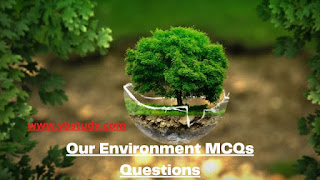Our Environment class 10 MCQ
MCQ on our Environment class 10 CBSE:
Our Environment is an important Chapter for class 10 students appearing for the CBSE board exam also. Below we are provided our environment class 10 MCQ online test Prepared by subject experts and students can refer to these Our Environment MCQ Questions for their CBSE board exam preparation. Below MCQ questions and answers are prepared for class 10 students.
CBSE board Aspirants can enhance their knowledge by regular practice which will help them crack any exam. These are environment class 10 quiz provided here that helps students to understand each Concept of the chapter easily and interestingly. Students can practice these MCQs thoroughly in order to score maximum marks in the CBSE board exam.
MCQ questions on our environment class 10:
1. In a food chain the second trophic level is occupied by
(a) Carnivores
(b) Autotrophs
(c) Herbivores
(d) Producers
Answer: Herbivores
2. Which of the following groups contain only biodegradable items
(a) grass, flowers, leather
(b) grass, wood, plastics
(c) fruit peels, cake,and lime juice
(d) cake, wood, grass
Answer: fruit peels, cake,and lime juice
3. Which of the following limits the number of trophic levels in a food chain
(a) Decrease in energy at higher levels
(b) Deficient food supply
(c) Polluted air
(d) Water
Answer: Decrease in energy at higher levels
4. DDT stands for____________
(a) Dichloro diphenyl trichloroethane
(b) Dichloro diphenyl tetrachloroethane
(c) Dichloro decaphenyl trichloroethane
(d) Dichloro diethyl trichloroethane
Answer:D dichloro diphenyl trichloroethane
5. Which of the following statements is incorrect?
(a) all green plants and blue-green algae are producers
(b) green plants get their food from organic compounds
(c) producers prepare food from inorganic substances
(d) plants convert solar energy to chemical energy
Answer: green plants get their food from organic compounds
6. Which radiation is responsible for the conversion of atmospheric oxygen to ozone?
(a) Gamma radiations
(b) Cosmic radiations
(c) Infrared radiation
(d) Ultraviolet radiation
Answer: Ultraviolet radiation
7. Excessive exposure to ultraviolet radiation causes________
(a) inflammation of liver
(b) cancer of skin
(c) damage to the lungs
(d) jaundice
Answer: cancer of the the sthe kin
8. Global warming is a phenomenon related to__________
(a) Evaporation
(b) Ecological balance
(c) Greenhouse effect
(d) Desertification
Answer: The greenhouse effect
9. _______is not a biodegradable pollutant.
(a)Paper
(b) Cotton cloth
(c) Cotton
(d) DDT
Answer: D
10. Which out of them is herbivore?
(a) Cow
(b) shark
(c) Lion
(d) Tiger
Answer: Cow
11. In an ecosystem, herbivores represent______
(a) producers
(b) primary consumers
(c) secondary consumers
(d) decomposers
Answer: Primary consumer
12. Which is not an abiotic factor
(a) Light
(b) plants
(c) Heat
(d) Temperature
Answer: Plants
13. An agricultural cropland is_____
(a) A biomass
(b) A natural ecosystem
(c) An artificial ecosystem
(d) None of these
Answer: An artificial ecosystem
14. Which of the following is non-biodegradable?
(a) Wool
(b) Nylon
(c) Animal bones
(d) Tea leaves
Answer: Nylon
15. Which group of organisms are not constituents of a food chain?
(a) Grass, lion, rabbit
(b) Plankton, man, fish, grasshopper
(c) Wolf, grass, snake, tiger
(d) Frog, snake, eagle, grass, grasshopper
Answer: Wolf, grass, snake, tiger
16. _____ is a terrestrial ecosystem
(a) A natural forest
(b) Lake
(c) Pond
(d) Aquarium
Answer: A natural forest
17. What is the most expensive component of solid waste handling?
(a) Collection
(b) Storage
(c) Treatment
(d) Separation
Answer: Collection
18. Depletion of ozone is mainly due to___
(a) chlorofluorocarbon compounds
(b) carbon monoxide
(c) methane
(d) pesticides
Answer: chlorofluorocarbon compounds
19. Ozone layer is damaged by______
(a) methane
(b) carbon-dioxide
(c) Sulphur-dioxide
(d) CFCs
Answer: CFCs
20. The plants which are light-loving plants are called ___
(a) Heliophytes
(b) Sciophytes
(c) mesophytes
(d) xerophytes
Answer: Heliophytes
21. Which of the following is a greenhouse gas?
(a) Oxygen
(b) Nitrogen
(c) Carbon dioxide
(d) Hydrogen
Answer: C
22. What is the primary cause of deforestation?
(a) Climate change
(b) Urbanization
(c) Agricultural expansion
(d) Industrial pollution
Answer: C
23. Which of the following is an example of a non-renewable resource?
(a) Solar energy
(b) Wind energy
(c) Natural gas
(d) Biomass
Answer: C
24. Acid rain is primarily caused by emissions of which gas?
(a) Carbon dioxide
(b) Nitrogen oxide
(c) Oxygen
(d) Methane
Answer: B
25. Which of the following is a major source of water pollution?
(a) Renewable energy plants
(b) Forest fires
(c) Industrial waste
(d) Volcanic eruptions
Answer: C
26. What is the process by which carbon is transferred from the atmosphere to plants?
(a) Photosynthesis
(b) Respiration
(c) Combustion
(d) Decomposition
Answer: A
27. Which of the following is a consequence of global warming?
(a) Increased biodiversity
(b) Rising sea levels
(c) Enhanced air quality
(d) Decreased rainfall
Answer: B
28. Ozone depletion is primarily caused by the release of which type of chemicals?
(a) Carbon dioxide
(b) Nitrous oxide
(c) Volatile organic compounds
(d) Chlorofluorocarbons (CFCs)
Answer: D
29. What is the term for the gradual increase in the Earth’s average temperature due to human activities?
(a) Desertification
(b) Acidification
(c) Global warming
(d) Ozone depletion
Answer: C
30. Which of the following is an example of a renewable energy source?
(a) Coal
(b) Oil
(c) Natural gas
(d) Solar power
Answer: D
These are some of the main MCQ questions on our Environment class 10 with Answers hope you Liked it.
